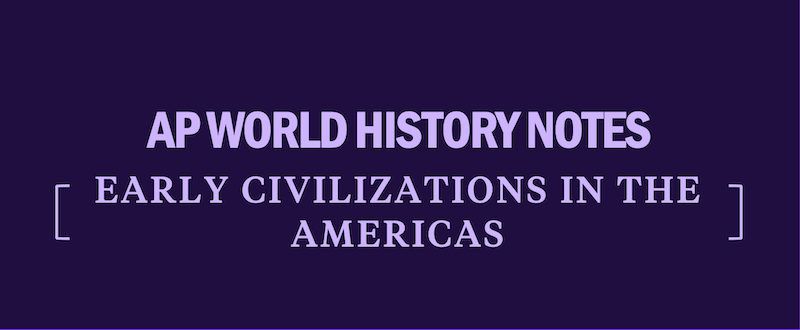Early Civilizations in the Americas: AP World History
Understanding the history of early civilizations in the Americas will prepare you for several high-yield topics on the AP World History: Modern Exam. Read on for a summary of some of the most significant early civilizations in the Americas, and check out our post on Major Events in the Americas for more info.
Table of Contents:
Early Civilizations in the Americas: Mexica Empire
The Mexica (also known as Aztec) people occupied territory in Mesoamerica, and the capital city Tenochtitlán was located in what today is Mexico City. A militant warrior tradition characterized their culture. They developed a system of feudalism, which had similarities to that of Japan and Europe. The Mexica were ruled by a single monarch, who exerted power over local rulers. In 1428, the Triple Alliance of three Nahua city-states, Mexico-Tenochtitlan, Tetzcoco, and Tlacopan, formed the Aztec Empire.
The Mexica had an agricultural economy, with cacao beans sometimes used as currency. They practiced chinampa agriculture, where farmers cultivated crops in rectangular plots of land on lake beds. A priestly class oversaw polytheistic religious rituals, which sometimes included human sacrifice. Although Mexica society was patriarchal, women were able to own property and agree to business contracts.
AP Expert Note: You may have noticed that a civilization traditionally described as Aztec is now primarily called Mexica. The term Aztec was popularized by earlier historians, but in recent years there has been a shift to a more accurate term, given that both the people of central Mexico and their later Spanish conquerors referred to this civilization as the Mexica people. Changes in terminology are the result of historical evidence being analyzed and debated. On the AP exam, especially in the free-response sections, be prepared to use the most accurate, current terminology.
Early Civilizations in the Americas: Inca Empire
Indigenous clans in the Andean highlands of South America developed a rich and complex culture, leading to the rise of an empire in the fifteenth century. These people, the Incas, conquered a large territory and absorbed many groups in central and western South America. In 90 years, the Inca Empire grew into a stretch of land that covered over 3,000 miles. The Chimor Empire, stretching along 620 miles of coastline, was the only regional rival of the Inca. Eventually conquered by the Inca after a war in the late fifteenth century, their territory and ruling elite were incorporated into the Inca Empire.
Despite its large size, the Inca Empire was centralized, led by a king and a privileged class of nobles. The capital city was Cuzco, in present-day Peru, but the Incas also occupied other large urban centers. The Inca Empire had a mandatory public service system, called the mit’a, where people had to serve for two months out of the year. This system allowed the Inca to develop an extensive road system, as well as provide armies that overwhelmed targets of imperial conquest.
The Inca lacked steel or iron; their weapons were typically made of wood, bone, stone, and cop- per. Surviving descriptions of the rope bridges that connected mountains and hilltops suggest the bridges were sturdy enough for conquistadors to gallop their horses across them at full speed.
The Inca economy was rooted in agriculture, as the people had adapted to the steep, rugged terrain of the Andes with the use of extensive irrigation techniques. The coca plant was viewed as sacred, and message runners would chew on leaves to maintain their energy across long distances. Inca religion was polytheistic, based on worship of the sun, and incorporated ancestor worship. They developed a system of record-keeping called quipu; it used knotted strings to record numeric data, such as tax obligations and census records. Descent was traced along parallel lines, father to son and mother to daughter.
Early Civilizations in the Americas: Maya City-States
From approximately 250 B.C.E. to 900, the Maya Empire occupied territory in modern-day Belize, Guatemala, Honduras, and southern Mexico. The Maya cosmos was divided into three parts: the heavens above, humans at the center, and the underworld below. Similar to the Egyptians, the Maya people built impressive pyramids, meant to be portals to the heavens. Warfare was imbued with sacred significance, as religious rituals would precede battle. The Maya also made huge contributions to mathematics and astronomy, particularly the concept of zero, as well as a modern calendar with 365 days.
In their postclassical period, from 950 to 1539, the Maya civilization persisted in a much-reduced form. Many of their cities and lands were abandoned, due to a combination of factors ranging from warfare to disease. The Maya settlements gradually shifted toward the Gulf coast. The Spanish conquest of the Maya took most of the seventeenth century. In contrast to the Inca or Mexica, the Maya were not unified into a single state or empire.
Early Civilizations in the Americas: Cahokia
Primarily located in the present-day American Midwest, the Cahokia Mounds are remnants of a pre-Columbian settlement of the Mississippian culture. The Mississippians existed from approximately the eleventh century to the mid-sixteenth century. Cahokia, their largest city, located near present day St. Louis, is believed to have been an important religious center. The Mississippians lacked a writing system, and due to a general lack of contact with Europeans until Old World diseases had thoroughly disrupted their society, little is known about them in comparison to other American Indian civilizations of the era. The Mississippians worked stone and copper. Their agriculture was centered around corn. They participated in trade networks that stretched from the Gulf of Mexico to the Atlantic, from the Great Lakes to the Rocky Mountains.




